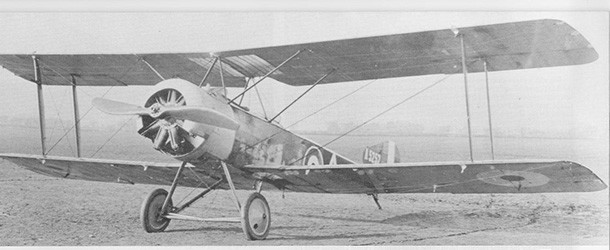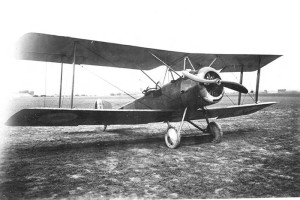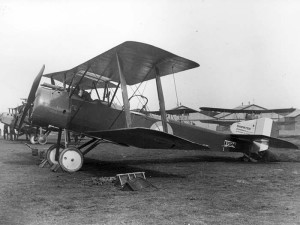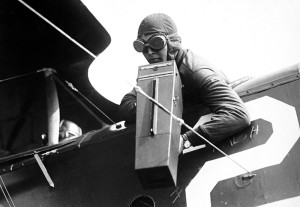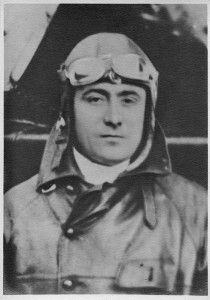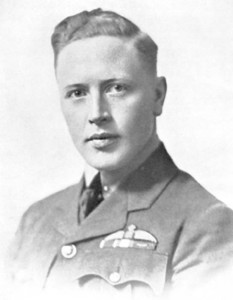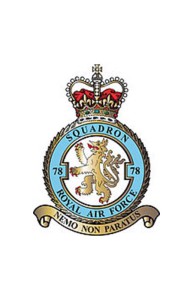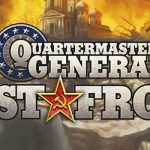Let’s learn more about one of the airplanes included in the latest series of WW1 Wings of Glory Airplane Packs, the Sopwith Strutter 1 ½ / Comic, a real protagonist of World War I, adopted by many nations during and after the war.
First ordered by Royal Naval Air Service, in need of both a single seat light bomber and a two seater fighter, the Sopwith 1 ½ Strutter answered this request as a multi-role aircraft. The first prototype had its first flight in December 1915, after a lengthy design period.
Thomas Sopwith, along with his engineers, realized a new aircraft with a biplane wing arrangement and an inline seating for pilot and observer/gunner. The Strutter 1 ½ was also the first British fighter equipped with a fixed machine gun, forward firing emplacement, synchronized to fire through the two-bladed spinning propeller blade - the observer used a rear Lewis machine gun instead .
The wings were supported by struts through full-length, while half-length struts were used to connect the upper wing assembly to the fuselage (known as cabane struts) and, this structure gave birth to the nickname of the aircraft (1-1/2 Strutter).
In addition to the British RNAS, this aircraft was widely used also by the French Aéronautique Militaire, and by many other nations, such as Belgium, Russia, and the USA.
After the success of the prototype testing, the Sopwith 1 ½ Strutter was put in production and from 1916 it functioned in a scout role to the bombers, such as Caudron G.4 and Breguet - but it was also equipped with bombs itself to carry out bombing raids itself.
Thanks to its possibility to execute long range raids, and for his excellent armament for that period, the Sopwith 1 ½ Strutter was used for offensive patrolling into German territories, until it was outclassed in power and speed by new German aircrafts, as Albatros fighters, decisively more efficient in dogfights. So in the following years, it was used as a long-range reconnaissance aircraft, with an adequate fighter escort. However, because German aircrafts were extremely superior and so many Strutters were shot down with serious casualties, in 1917 they were replaced by the Sopwith Camel.
But the Strutter was not left behind, and thanks to its long range and stability, it was used for home defense. Originally built as two-seaters, the Strutters used for this purpose were converted into single seaters to improve their performances, giving birth to the Sopwith Comic. This version had the cockpit moved back, behind the wings, and its Lewis machine guns were mounted outside the arc of the propeller.
The French Aéronautique Militaire adopted the Strutter in large numbers, in three different versions: two-seaters for reconnaissance and for bombing and single seater for bombing.
The Strutter was used to bomb industrial and military objectives, and it performed this role well; but in dogfights against German fighters it proved itself an easy target, with many casualties, so in early 1918 Sopwith 1 ½ Strutter was withdrawn by the Aéronautique Militaire.
As many other aircrafts of this period, the Sopwith Strutter suffered the evolution of the aviation design and engineering, with new models that overtook the previous ones. In the end, it was replaced by Sopwith Pup and Sopwith Triplane that pressed into second-line roles the Strutter, and it was used less and less till the end of the war.
Sopwith Strutter 1 1/2 in Wings of Glory
In Wings of Glory, the Sopwith Strutter 1 ½ is featured in three versions: two versions for the two-seater and one for the one seater, the Comic. This aircraft has been especially used by British and French air forces, and in this series we introduce some aces as the French Dieudonné Costes and the Canadian Raymond Collishaw, and a Comic piloted by members of 78th Squadron of Royal Air Force. These planes use the V maneuver deck, a deck with not so many available maneuvers, but still fast to sustain a dogfight against the German aircrafts. It has a very useful addition to the usual two-seaters' decks: the dreaded Immelmann turn, especially effective for a plane that's armed both in front and to the rear. This is the earliest two-seater with this maneuvre, a rare distinction shared with the later Bristol F2B and Cl. class German planes.
The two Airplane Packs featuring the Strutter 1 ½ includes an additional card introducing the optional rule “Flying doctrine”. The two-seater versions of the Sopwith 1 1/2 Strutter were able to perform reverse maneuvers, but initially, because of training and doctrine, crews did not attempt such acrobatic maneuvers. If this rule is in use, the player have to remove the Immelmann card from the two-seater Strutter's maneuver deck.
For the Sopwith Comic, the Airplane Pack features two additional cards for the optional rule “Fixed higher machine gun,” to represent the way the machine gun on the upper wing of the Comic is used to fire upward. In the first version, used with Basic and Standard rules, the Comic can fire with an Aim bonus against an overlapping airplane in its firing arc, and the shot is considered at short range. As a restriction, the Comic cannot fire at long range after a steep maneuver. In the Advanced rules version(used when if altitude rules are in use), the Comic can fire at long range with a +1 Aim bonus at an overlapping airplane in its firing arc, if it is exactly one level above. It can also fire at short range with a +1 Aim bonus at overlapping airplanes in its firing arc at the same level. As restrictions, it cannot fire at long range at targets at the same altitude level after a steep maneuver and it cannot fire to any target at a lower altitude level.
Dieudonné Costes
Dieudonné Costes had been a great aviator and ace for the French aviation, but he became most famous for his great long distance flights records. He was born in Septfonds, Tarn-et-Garonne, on November 14th, 1892, and got the pilot diploma in 1912, just in time for the imminent war.
During World War I he served in the French Air Service, changing between many squadrons. He started in MF55 and MF85 Farman squadrons, then he was transferred in N506, N507 and N531 fighter Nieuport squadrons, fighting along the Balkan front. He shot down 8 enemy aircrafts from April 1917 to September 1918, ending the WWI with the 2nd Lieutenant grade.
But he became a celebrity after the war when, in the civilian aviation, he started doing long distance flights. He started with Toulouse-Casablanca route, then he flew on Bordeaux-Paris route in 1921 and on Paris-London route in Air Union airlines in 1923. From 1925 he became a test pilot in Breguet works starting the real long-distance flights, breaking records and becoming part of the flight history.
In September 1926, he flew 4,100 km (2,546 miles) from Paris to Assuan, with René de Vitrolles, trying to break the world distance record, that he broke on October 28, 1926, flying 5,396 km (3,351 miles) from Paris to Jask, Persia, with J. Rignot, as a part of 19,625 km (12,187 miles) Paris-India-Paris flight.
Between October 10, 1927 and April 14, 1928, Costes and Joseph Le Brix flew 57,410 km (35,652 miles) around the world, in Breguet 19GR named Nungesser-Coli, from Paris through Argentina, Brazil, the United States, Japan, India, and Greece, even if they traveled across the Pacific Ocean from San Francisco to Tokyo by ship. During the trip, they made the first non-stop aerial crossing of the South Atlantic Ocean on October 14–15, 1927, flying between Saint-Louis, Senegal, and Natal, Brazil.
On July 13, 1929, Costes and Maurice Bellonte made an attempt at crossing the North Atlantic Ocean westbound, from Paris to New York, flying on the Breguet 19 Super Bidon nicknamed “?” ("Point d'Interrogation" - that is, “Question Mark”). They returned after 17 hours, however, due to bad weather. But few months after they broke the world distance record, flying 7,905 km (4,909 miles) from Paris to Qiqihar in China.
Another great exploit by Costes and Bellonte was flying from Paris to New York, again on the "Point d'Interrogation", as the first heavier-than-air aircraft to reach New York in the more difficult westbound direction between North America and Europe, covering either 5,850 km (3,633 miles) or 6,200 km (3,850 miles), according to different sources, in 37 hours 18 minutes.
During World War II Costes was an instructor in a piloting school in Versailles, as a lieutenant colonel, and he survived also WW2, dying in 1973 in Paris. During his life, he achieved many awards, as Legion of Honour, Croix de guerre, and the Médaille militaire; for his incredible flights around the world, he inherited the 1929 Fédération Aéronautique Internationale Gold Medal and the 1929 Harmon Trophy, while in 1928 he was awarded the Distinguished Flying Cross by special act of the Congress of the United States, in recognition of his historic flight around the world.
The airplane pack featuring his Strutter includes an Ace Card with the "Sharp Eye" skill.
Raymond Collishaw
The most victorious Sopwith Triplane pilot, Raymond “Collie” Collishaw was the highest scoring Royal Naval Air Service (RNAS) ace and the second highest scoring Canadian pilot of the WW1, with 60 victories – 34 achieved flying the “Tripehound.” Born in British Columbia, Canada, in November 1893, Collishaw joined the RNAS in January 1916, and flew naval patrols in the British coast for seven months.
In August 1916, he was assigned to the RNAS's 3rd Wing, operating in France, and started to fly the Sopwith 1½ Strutter. He took part in the famous raid against the Mauser Rifle Factory at Oberndorf, Germany, on October 12, 1916, where he claimed his first victory, although it was not officially confirmed. On October 25, he scored a double victory over Luneville. Attacked by six enemies that dove out of the clouds, he was able to rout the German planes, downing two of them while the other flew off. This impressive flight led France to grant him the “Croix de Guerre” award.
Posted to the No. 3 Naval Squadron in February 1917, Collishaw flew the Sopwith Pup for two months. In April, he was given command of "B" Flight of No. 10 Naval Squadron, formed entirely for Canadian pilots and equipped with Sopwith Triplanes. This fighting unit became the famous and redoubtable "Black Flight."
Painted black (though appearing dark brown), the Triplanes of the unit were named Black Maria, Black Death, Black Roger, Black Prince, and Black Sheep. In two months, June and July, the Black Flight downed 86 aircraft loosing only three, two of them to anti-aircraft fire. Considering the unit engaged dogfights with J.G.1 and Richthofen's Flying Circus, these numbers are even more impressive.
Collishaw flew three Sopwith Triplanes at the No.10 Naval Squadron, all named “Black Maria,” and the third one is depicted in the Wings of Glory Airplane Pack. This aircraft was one of the few Tripehounds built by Clayton & Shuttleworth with twin guns. From April 28th to July 27th, Collishaw scored 34 victories, and was the first pilot to claim six victories in one day - on July 6th, over Menin. In August, he returned to Canada for a leave and the Black Flight unit was disbanded.
Back to the war in November, Collishaw was given command of No.13 Naval Squadron, operating from Dunkirk and doing escort duty with the Channel Patrol. In January 1918, he was posted to command the No.3 Naval Squadron (which became No. 203 Squadron Royal Air Force when RNAS and RAF merged in April 1918), returning to fight on the Western Front until September 1918. Flying the Sopwith Camel, he achieved another 21 victories.
When the Armistice was signed, Collishaw was in England working on the formation of the Royal Canadian Air Force. During WW1, he was awarded the Distinguished Service Cross, the Distinguished Flying Cross, the Distinguished Service Order with bar, and the French Croix de Guerre.
After the war's end, he remained in the Royal Air Force and served as a commander of a Fleet Air Arm Fighter Group in WW2. During the war, he attained the rank of Air Vice Marshal and was awarded a Companion of the Order of the Bath during his service. He retired, involuntarily, from the RAF in July 1943. His memoir, titled “Air Command, A Fighting Pilot's Story,” was published in 1973, and he died on September 28, 1976, in West Vancouver, British Columbia, at the age of 82.
Collinshaw's airplane pack features an Ace Card with the "Sniper" skill.
78 Squadron
The No. 78 Squadron was part of the Royal Flying Corps, formed for home defense with the task of protecting the southern English coast.
This squadron was originally equipped with BE2 and BE12 fighters and was responsible for intercepting the incoming Zeppelins as they attacked targets on the south coast, moving some six months later to London to defend the capital when German bomber raids started.
The squadron received Sopwith 1½ Strutters in late 1917, followed by Sopwith Camels in mid-1918. The squadron disbanded on 31 December 1919 following the Armistice.
Information sources: WorldWar1.com, The Aerodrome, All the World's Rotocraft, Wikipedia, Royal Air Force, Wikimedia, World War I in Photos, FlyingMachines.ru, Time and Navigation, The Great War Flying Museum. .

